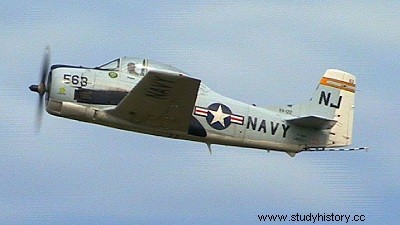
Airplane :North American T-28A Trojan.
Manufacturer :North American Aviation Inc.
Type :statement.
Year :1949.
Engine :Wright R-1300-1 800 HP air-cooled 7-cylinder radial Cyclone.
Wingspan :12.21 m.
Length :9.75 m.
Height :3.86 m.
Take-off weight :2,887 kg.
Maximum speed :455 km/h at 1,800 m altitude.
Maximum operating altitude :7,300 m.
Range :1,600 km.
Armament :—
Crew :2 people.
It is the last propeller-driven training aircraft designed as such and built in large quantities. The Americans made the North American T-28 Trojan in 1948 with the aim of replacing the T6 Texan, still valid but old for the time. However, the T-28 had a much more limited operational career than that of its predecessor:the USAF used 1,194 examples in front line detachments until 1956 and in reserve until 1959, while the The US Navy ordered another 790, which it kept in service from 1953 until the late 1960s.
At some point in its career, this aircraft saw a very unusual job for a training machine:it was converted into a ground attack and anti-guerrilla aircraft and, in this role, served mainly within the French Air Force which, in 1960, bought 245 specimens of the initial version - at the time written off by the USAF -, put them on line under the name of Fennec and employed them in Algeria. In 1948, the need for an aircraft that could be used for both initial and basic training led the USAF to request the creation of a new training machine.
North American won the competition, with a project called NA-159. Accepted under the official designation of XT-28, the prototype flew for the first time on September 26, 1949. The Trojan was presented in the form of an elegant monoplane with low wings, entirely metal and equipped with a fully retractable nose tricycle landing gear .
The student and the instructor were placed in tandem under a large transparent "bubble", which allowed maximum visibility. The manufacturer had chosen a seven-cylinder Wright R1300 Cyclone as the engine, capable of developing 800 horsepower and driving a two-bladed variable-pitch metal propeller. Given its power characteristics, the T-28 appeared much more "difficult" than the T-6 but, in reality, it proved to be docile to command, easy to pilot and did not show the slightest defect. The front tricycle gear, which was an absolute novelty in the field of instruction, required some adaptation on the part of the student pilots. Finally, the American technicians had also provided for the possibility of installing on-board armament:two 45-kilogram bombs under the wings, or six rockets and two machine guns.
At the end of the tests, in 1950, the United States placed a first order of 266 copies. Subsequent orders brought the total number of machines built to 1,194. These aircraft bore the designation T-28A and all served in the USAF Air Training Command. In 1952, the Navy also took a real interest in the Trojan. From then on, she asked for the realization of a version adapted to her own needs, characterized above all by a greater power. The North American manufactured in a short time the prototype of the T-28B, which flew for the first time on April 6, 1953. Apart from slight structural modifications, this machine differed essentially by the choice of the engine, which became a Wright R- 1820 of 1,425 HP driving a three-blade metal propeller with variable pitch.
The Americans noted a considerable increase in the performance of the device and, at the end of the tests, accepted the T-28B of which they ordered 489 copies. In 1955, they placed a new order for a model capable of operating on board aircraft carriers. This one was called T-28C and kilos under the wings, or six rockets and two machine guns.
At the end of the tests, in 1950, the United States placed a first order of 266 copies . Subsequent orders brought the total number of machines built to 1,194. These aircraft bore the designation T-28A and all served in the USAF Air Training Command. In 1952, the Navy also took a real interest in the Trojan. From then on, she asked for the realization of a version adapted to her own needs, characterized above all by a greater power. The North American manufactured in a short time the prototype of the T-28B, which flew for the first time on April 6, 1953. Apart from slight structural modifications, this machine differed essentially by the choice of the engine, which became a Wright R- 1820 of 1,425 HP driving a three-bladed variable-pitch metal propeller. The Americans noticed a considerable increase in the performance of the device and, at the end of the tests, accepted the T-28B, of which they ordered 489 copies.
In 1955, they placed a new order for a model capable of operating on board aircraft carriers. This one was called T-28C and its prototype flew on September 19 of the same year. The main changes resided in the lengthening and strengthening of the fuselage - in order to allow the installation of the landing hook and to resist the particular stresses involved in on-board employment - and in the adoption of a propeller with a larger diameter small in order to avoid accidents resulting from the sudden and violent lowering of the front under the action of the arresting cable. The US Navy received a total of 301 T-28Cs.
